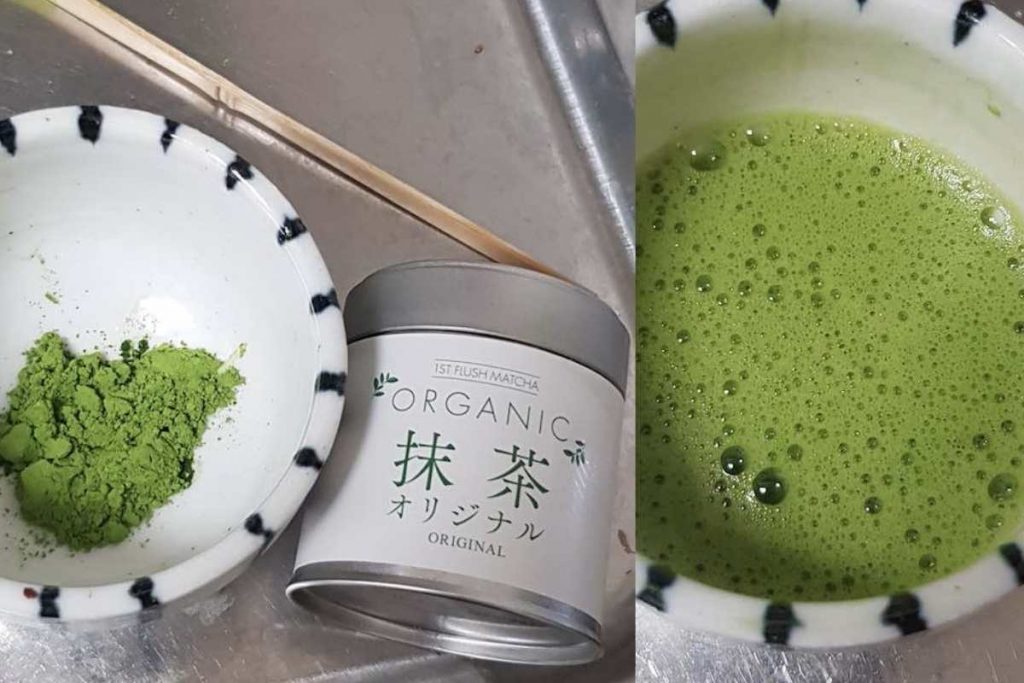Organic is not always tastier or more attractive, for any food, and this is true of green tea and matcha in most cases. But is organic matcha safer? Probably not. The best-tasting and best-looking matcha is mostly not organic, and non-organic matcha from Japan (and the U.S.) is reliably safe.
The definition of “organic” also varies from country to country, and Japan has very high food safety standards. This may be one reason organics, after all these years, still have little following in Japan. Other countries are a different matter.
But there are some terrific organic matcha brands from Japan (and other places) and more are emerging.
So, what are the differences between organic and non-organic matcha, and is non-organic safe and/or is organic safer? The main areas are:
- Fertilization and production
- Safety standards
- Tradition
- Final product
- Personal preference and the effects of marketing
Hopefully, this can inform your decision. As usual, I’ll bring you the science behind the enjoyment.
Why matcha green tea plants need fertilizer
Matcha is a fine powder made from green tea leaves. It’s grown using a precise shading technique on the Camellia sinensis plant. It’s a highly regulated and precise process.
The differences between matcha and tea are in this preparation, as well as in the soil, fertilizer, and sun exposure.
Around since 12th-century Chan Buddhist rituals, matcha is a finely ground powder of specially produced and refined green tea leaves from East Asia. Long before organics were a thing, matcha has been prepared, and it’s been healthy and safe.
What’s generally considered the best quality matcha is only grown in three regions in Japan: Uji in Kyoto Prefecture, Nishio in Aichi Prefecture, and in the south in Kagoshima Prefecture. These have the most favorable soil and climate conditions, with Uji matcha considered tops.
Kyoto and Aichi have slightly more acidic red-yellow soil, which is derived from mica-bearing rocks. It consists of different biomass, and that has quite a significant impact on its fertility compared with other plantation areas.
Acidic soil allows the tea plant to flourish because it lacks accessible phosphorous. This decreases the production of secondary metabolites but influences the tea with a wide range of amino acids.
The main difference between regular green tea and matcha tea is in the growth phase, when direct sunlight on matcha tea is blocked by shading. By reducing direct sunshine exposure, chlorophyll, amino acids, and theanine accumulate in the leaves. This results in increased sweetness and decreased bitterness.
To achieve the best flavor, two fertilization steps need to follow. The first one takes place at the beginning of the year (usually January and February). The second fertilization is done a few months later (usually in April and May), during the shading of the leaves.
Research showed that fertilizers such as pure nitrogen give more rapid results, and can also be mixed with organic fertilizers at different growth stages. Nitrogen affects the plant in several ways. It accelerates plant growth, increases the amount of amino acids, and is used to help older plants produce new shoots (productive centers of plants).
Fish meal is another common fertilizer. Neither nitrogen nor fish meal would likely be considered hazardous.
Use of compound fertilizers is known as well. A combination of nitrogen, potassium, and micronutrients was found to increase caffeine content in the tea leaves.
Does matcha “need” these fertilizers? That’s a matter of the grower’s preference and a matter of marketing. The Japan External Trade Organization (JETRO) notes the growing popularity of organic matcha but gives no reason why.
Safety standards for non-organic matcha
Japanese organic matcha falls under the government-regulated Japanese Agricultural Standards (JAS) for organics. JAS organic is equivalent to the USDA standard. However, it’s said that Japanese non-organic safety standards may even be stricter than organic standards.
Japan’s Positive System of Agricultural Chemicals (JPSAC) strictly regulates herbicide and pesticide use in matcha production. Reports have to be submitted to the authorities regularly. In addition to this, chemical residues on tea leaves are tested as the final safety standard check.
In comparison, the US Environmental Working Group (EWG) analyzes common toxin and pesticide residues in matcha, annually. Being a tea, matcha falls under FDA Nutrient and Labeling regulation.
Controversies surround matcha produced in China. It’s scrutinized for poorer quality and production with lacking regulatory standards. In the past, imported Chinese matcha was tested positive for several banned pesticides.
Organic matcha may not be safer or taste better
European and US consumers are increasingly searching for organic products. The trend exists in the East, but less so. The simple line of thought is that if organic ensures no pesticides and other harmful substances, so it must be healthier. And the general line of thinking is that the more “pure” something is, the more natural it is.
The main difference between organic and non-organic matcha is the farming method. Producing high-quality organic matcha is very limited geographically in Japan. Reproducing the quality is much harder compared with non-organic.
Traditionally produced matcha has eight centuries of tradition and has a very broad grading system. The grades vary from cooking grade to ceremonial grade (saved exclusively for Japanese tea ceremonies).
In contrast, organic matcha production is only about a decade old with a fairly narrow grading system. That means, on the one hand, it may not yet taste as good, but on the other hand, it may be catching up.
When it comes to safe consumption, certainly all Japanese matcha is considered safe as long as it’s consumed in reasonable amounts.
Caffeine found in green tea can cause a variety of side effects, with diarrhea, headache, irritability, and insomnia being only some of them. It also has plenty of benefits, such as energy, focus, healthy bowel movements, and even hair growth.
Regardless of matcha being organic or non-organic, some contaminations were reported. Arsenic, phosphorous, and lead is commonly absorbed through the soil into the plant, though not typically at levels anywhere near worrying about.
Regulatory agencies do monitor matcha production (JPSAC in Japan, and the FDA in the US). Organic production can be certified through the US Department of Agriculture (USDA) and Japanese Agriculture Standards (JAS).
Finally, the safety of any type of matcha is not proven completely, as clinical trials are missing. But the future is promising, and further safety inspections are to be done in the upcoming years.
What to look for when choosing “safe” matcha
Several factors should be taken into consideration when choosing “safe” matcha. First, knowing who it’s for, and then reading the instructions.
Almost everyone can consume matcha tea. The exception is pregnant and nursing women, who are recommended to avoid it altogether. In addition to this limitation, the mental state of “the more the better” doesn’t necessarily apply to matcha.
Of course, when choosing the right matcha product for yourself objectiveness is the key. Looking for certifications and relevant laboratory tests on the packaging is necessary to be sure you’re consuming a safe product. An example of this can be the USDA certificate for US products or the JAS certificate for Japanese products.
When looking for worldwide accepted organic certification, ECOCERT and CERES are good ones to follow when buying e.g. in Canada or Europe. When buying internationally, ISO (ISO/CD TR 21380) and HACCP standards are good measures of safety and quality.
Organic vs. non-organic? Does it really matter?
The differences between organic and non-organic matcha do exist.
The contrasting use of fertilizers gives separate nutritional compositions, resulting in varying color, texture, and taste.
Organic fertilizers take longer (over 3 months) to effectively work. They don’t provide enough energy for plant growth. This leads to less than optimum amino acid (theanine), and chlorophyll content (hence inferior color, and weaker, less rich taste and sweetness).
There’s no simple answer on whether to choose organic or traditionally grown matcha. It’s purely subjective and depends on your taste preference. With the rise in Western interest in matcha, we can expect more organics to appear, as with other foods. That may not mean they’re “safer” or “better,” though. It may just be opportunistic marketing.
Is organic matcha safer? Maybe just a very bit, but unlikely unless you’re talking about non-Japanese matcha. Better? No.
The best matcha has a rich, deep emerald green, earthy scent, creamy texture, satisfying umami, and low bitterness. For me, that’s the non-organic matcha from Uji and Nishio. I’ve had outstanding organic matcha, but it doesn’t match up to the really good non-organic…yet.
To see how intense and exacting, and clean, the matcha-growing process is, this is a great video from NHK:

